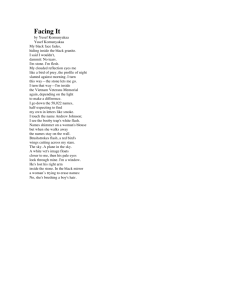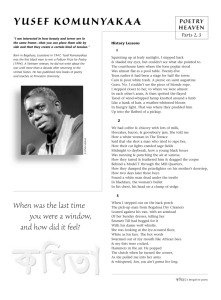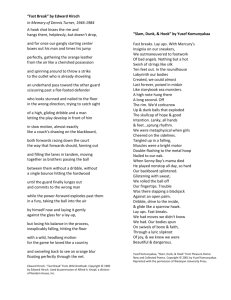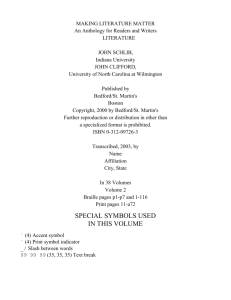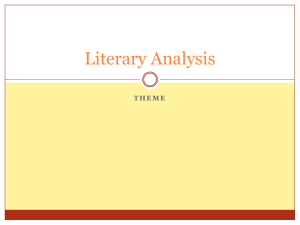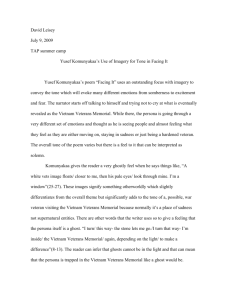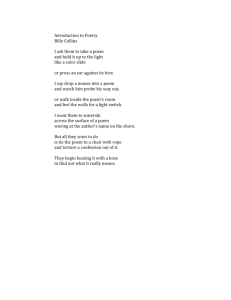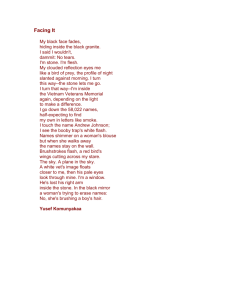Significance of Komunyakaa's Poetic Choices by Kaitlin
advertisement
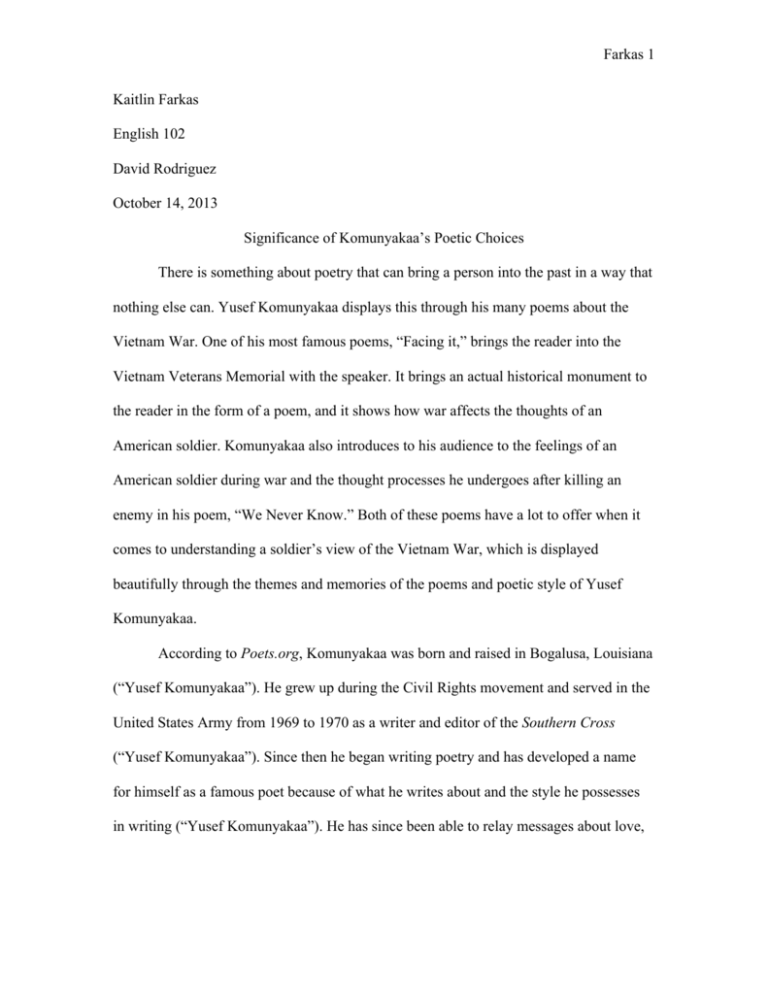
Farkas 1 Kaitlin Farkas English 102 David Rodriguez October 14, 2013 Significance of Komunyakaa’s Poetic Choices There is something about poetry that can bring a person into the past in a way that nothing else can. Yusef Komunyakaa displays this through his many poems about the Vietnam War. One of his most famous poems, “Facing it,” brings the reader into the Vietnam Veterans Memorial with the speaker. It brings an actual historical monument to the reader in the form of a poem, and it shows how war affects the thoughts of an American soldier. Komunyakaa also introduces to his audience to the feelings of an American soldier during war and the thought processes he undergoes after killing an enemy in his poem, “We Never Know.” Both of these poems have a lot to offer when it comes to understanding a soldier’s view of the Vietnam War, which is displayed beautifully through the themes and memories of the poems and poetic style of Yusef Komunyakaa. According to Poets.org, Komunyakaa was born and raised in Bogalusa, Louisiana (“Yusef Komunyakaa”). He grew up during the Civil Rights movement and served in the United States Army from 1969 to 1970 as a writer and editor of the Southern Cross (“Yusef Komunyakaa”). Since then he began writing poetry and has developed a name for himself as a famous poet because of what he writes about and the style he possesses in writing (“Yusef Komunyakaa”). He has since been able to relay messages about love, Farkas 2 pain, music, war, and many other topics through his poetry to the hearts and minds of those who read his work. Yusef Komunyakaa uses perfect word choice in both of these poems to illustrate a picture or scenario that engulf the reader to where he or she is with the narrator, feeling what he feels. For example, in “Facing It,” the speaker thinks to himself, “My black face fades, / hiding inside the black granite” (lines 1-2). Komunyakaa describes the black granite as a mirror, and he chose to use the word “black” to describe the speaker’s face and the color of the granite. The identity of the speaker becomes lost within the black granite, which shows the internal conflict he is having with himself because of his race. The way that he fades into the granite also shows that his Vietnam experiences differ from the white soldiers because of his race (Johnson). In his poem, “We Never Know,” Komunyakaa carefully explains the death of one of the enemies: He danced with tall grass for a moment, like he was swaying with a woman. Our gun barrels glowed white-hot. When I got to him, a blue halo of flies had already claimed him. (1-7) Choosing the words “danced” and “swaying with a woman” illustrates peacefulness to the fact that the speaker is in the process of killing one of the opponents. He is looking at him almost as if in awe of the man as he gracefully claims death. Also, Komunyakaa Farkas 3 chose the word “white” to describe the color of the gun barrels after killing the man. White often signifies innocence. The speaker believes the man he just killed is innocent and feels bad about it, which is why he went to the corpse of the soldier. The words “blue halo” are placed in a part of the poem that confirms the feelings of the American soldier to the reader. The color blue alludes to sadness, which is what the speaker is feeling. And the detail of the halo describes the man as an angel, which is a holy and serene figure. Both poems also have a memory or flashback toward the middle of the poem. In “Facing It,” the flashback occurs when Komunyakaa writes, “I touch the name Andrew Johnson; / I see the booby trap’s white flash” (17-18). Andrew Johnson was a part of the army infantry from Komunyakaa’s hometown of Bogalusa, Louisiana (Semansky). He was killed in Vietnam in 1967 (Semansky). The “booby trap’s white flash” refers to a memory of the past, which can be safely assumed to be the reason for the death of Johnson. Similarly, Komunyakaa also does this in “We Never Know” when he describes the picture that the speaker takes from the dead soldier. Komunyakaa writes, “I pulled the crumbled photograph / from his fingers. / There’s no other way / to say this: I fell in love” (8-11). Komunyakaa did not directly use a flashback in this instance, but he gave the reader an opportunity of a memory that is associated to the picture. By looking at the picture, the speaker realizes that this soldier is a real person, not just an enemy. He has family, friends, and loved ones, and from that point on, all they have now is the memory of the soldier since he was killed. By using memories and flashbacks in his poems, Komunyakaa helps the reader connect with the poem and the speaker on a personal and emotional level. Farkas 4 Another focal point in the two poems is their endings. Komunyakaa often invests in the value of the unexpected in poetry (Johnson). He will often take a sudden and surprising turn toward the end of his poems. His poem, “Facing It,” demonstrates this style as the poem comes to an end: “In the black mirror / a woman’s trying to erase names: / No, she’s brushing a boy’s hair” (29-31). Komunyakaa shifts from his perspective to that of another mourner. At first he compares the woman’s gesture to erasing names from the granite, but he then moves the reader into the woman’s mind and writes from her perspective (Johnson). Komunyakaa connects the woman’s movement with a maternal caress. The woman suggests a different method of confronting the past and obtaining comfort for the sorrows of history (Johnson). In contrast, Komunyakaa does not take this approach with the ending of “We Never Know.” In this poem, he uses the ending to confirm how the soldier feels toward the death of the enemy. He concludes, “I slid the wallet into his pocket / & turned him over, so he wouldn’t be / kissing the ground” (15-17). Throughout the poem, it seems as if the soldier feels sorrow toward the dead enemy. He turned the corpse over on his back so that his face was not in the dirt. This displays an act of courtesy toward the enemy and confirms the speaker’s sorrow and affection toward him. To conclude, Komunyakaa allows the readers of these two poems the opportunity to step into the minds and hearts of soldiers and feel what they feel through the strategies he uses to convey the message. Both of the poems display the techniques that Komunyakaa uses to make his poetry different and relatable to the different audiences that partake in his writing. Farkas 5 Works Cited Chris Semansky. “Critical Essay on ‘Facing it.’” Poetry for Students 5 (1999): n. pag. Literature Resource Center. Web. 5 Oct. 2013. Johnson, Jeannine. “Critical Essay on ‘Facing it.’” Poetry for Students 5 (1999): n. pag. Literature Resource Center. Web. 5 Oct. 2013. Komunyakaa, Yusef. Pleasure Dome New and Collected Poems. Middletown: Wesleyan University Press, 2004. Print. “Yusef Komunyakaa.” Poets.org. Academy of American Poets, n.d. Web. 1 Oct. 2013.
